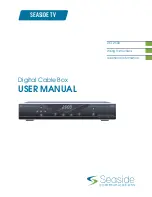
Before you begin:
Load Cartridge
An OCC cartridge needs to be loaded into the Divot® Module before
use. Six sealed cartridges are included in the case.
n
Loading an OCC Cartridge
You do not need to remove the Divot® module from the patch cable
when loading a cartridge.
End Cap
1
Unscrew and remove the
End Cap
to expose the split sleeve.
2
Remove the two plastic tabs (located on each end) from one of the
OCC cartridges included. Leave remaining cartridge sealed until
ready for use.
l
Tabs
l
l
3
After removing the tabs from the OCC cartridge, push the larger end
into the sleeve.
4
n
Connect patch cable to OTDR or test equipment.
n
Break out a few inches of the fiber to be tested down to 250µm buffer.
Strip fiber down to 125µm cladding. Cleave fiber leaving a minimum of 3/4”
of fiber. Clean or wipe off fiber if needed.
n
Insert your prepared bare fiber end into the round opening on the end of
the OCC cartridge protruding from the Divot® module.
The bare fiber will be stopped by the attached patch cable assembly. If a connection is not
made on the first insertion, pull the fiber back slightly into the module and push forward again.
If using uncleaved fiber and are unable to get a successful connection after a few attempts,
remove the fiber and rebreak or cut the fiber again.
n
Proceed with testing.
OTDR
Divot® Module
Fiber
Getting Started
Instructions
Screw on the End Cap until it stops. The Divot® Module is now
loaded and ready for use. Place the dust cap included in the case
(not shown) onto the end of the cartridge protruding from the Divot®
module when storing the unit.
5
Insert Divot® module into the Desktop Mount/Holder by removing the
top half of the holder. Place the Divot® module into the cut out
section on the bottom half of the holder. Place the top section over
the Divot® module. The top section is held in place by magnets.
There should be a slight gap between the top and bottom section of
the Desktop Mount/Holder.
6
Caution: Always wear protective eyewear when working with bare or active fiber. Never look
into the end of the Divot® Module when patch cable is connected to active test equipment.
Questions? Please contact Customer Service at 1-866-640-3468 or visit www.fiberplus.com.
?
2












